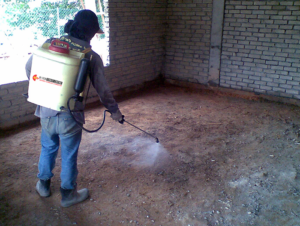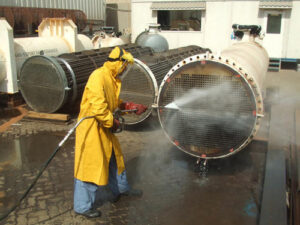Cabinet refinishing is a great option for homeowners looking to modernize their cabinets without the financial commitment of full replacement. It’s also the best choice for preserving historic or antique cabinets that are structurally sound but dated in appearance.

However, refinishing isn’t an option for laminate or thermofoil materials as they cannot be sanded or chemically stripped to accept paint. Contact Cabinet Refinishing Modesto Anchor for professional help.
When it comes to revitalizing your kitchen, you’ll want results that last. Fortunately, cabinet refinishing and refacing offer innovative solutions that allow you to achieve a brand new look without the cost, time, and challenge of a full-scale renovation.
Cabinet refinishing, also known as repainting, breathes fresh life into your existing cabinets by changing their color or finish. While this update is typically cheaper and less labor-intensive than a full replacement, it doesn’t offer the transformative impact that refacing does.
If your cabinet boxes are in good shape and the style you like, refinishing is an excellent option for achieving a new look. The key is to ensure that the surfaces are clean and free from grease and grime. Then, a light sanding is performed to create a smooth surface and make sure the paint adheres properly. Finally, a high-quality primer is applied to help the surface resist moisture and stains.
After the primer has dried, the surfaces are ready to be painted. A variety of colors and finishes are available, making cabinet refinishing a highly customizable solution that allows you to achieve a modern, sleek, or rustic feel. Homeowners can even change the color of their cabinet hardware during this process to achieve a personalized aesthetic.
In addition to delivering high-quality, long-lasting results, cabinet refinishing is environmentally sustainable. By utilizing the existing structure, you eliminate the waste associated with manufacturing and disposing of new materials. In addition, refinishing can be done at a much faster rate than refacing and is more cost-effective.
The DIY route may sound appealing, but it can result in subpar results that do not withstand the test of time and heavy use. A professional cabinet refinishing service uses specialized techniques and premium materials to deliver exceptional results that elevate your home’s ambiance and value.
With the right preparation and expert technique, you can expect your refinishing project to last up to 10-15 years before it needs to be touched up. If you have any questions about your refinishing project or would like to know more about the other services we provide, contact us today!
Time-Saving
Cabinet refinishing is a much faster option than replacing your cabinets. It is also more cost-efficient, and you can still have the look that you want in your home without paying for a full overhaul of your kitchen or bathroom. This is especially true if your existing cabinets are in good condition and you just want to change the color, as opposed to replacing the entire cabinet.
The reason why refinishing is so fast and efficient is because it involves fewer steps than refacing. Refacing is a more extensive process, which includes removing and replacing all of the doors, hinges, handles, and drawer pulls as well as sanding down the entire surface area of the cabinet boxes. This takes a lot more time and energy than simply refinishing your cabinets.
Another way that refinishing saves you time is by eliminating the need to wait for new cabinet doors and hardware to be manufactured and shipped to your home. When you choose to refinish your cabinets, your new look will be ready for you to enjoy in just a few weeks. This is especially helpful if you have a busy lifestyle and need to get back to your normal routine quickly.
However, refinishing requires careful prep work, which can prolong the duration of your project. If you are refinishing cabinets that have been previously painted or stained, this will require additional time to strip the surfaces and repair any damage. This is why it is important to hire professionals who have the knowledge and experience needed to complete a quality job that will last for years.
When you choose to refinish your cabinets, the materials from your old cabinets will not end up in landfills as they would if they were replaced. This is a major benefit for those who are environmentally conscious and want to reduce their carbon footprint. Additionally, refinishing often uses water-based and low-VOC paints and stains, which are even more environmentally friendly than traditional options.
If you are thinking about a DIY cabinet refinishing project, make sure to clean your cabinets and remove all of the hardware before starting. This will ensure that your finish will be as smooth and seamless as possible. You should also begin by painting the inside of your cabinetry and the bottoms before moving on to the fronts. This will help prevent you from having to flip your cabinets over multiple times, which can lead to unsightly streaks and blobs.
Affordability
Cabinet refinishing is a more budget-friendly option than replacing cabinets, especially if your existing doors and drawer fronts are in good condition. This process involves stripping and sanding your existing wooden surfaces and then applying a new stain or paint. This is ideal for homeowners who want to refresh the look of their kitchen but don’t have a lot of money to invest in a full renovation. Cabinet refinishing is also a great choice for high-traffic areas that require durable finishes.
This is a DIY-friendly project that can be completed in just a few days with minimal downtime. However, it is important to hire a professional for proper prep and a flawless finish. Hiring a cabinet refinishing company will also ensure that the results are long-lasting and resistant to heat, moisture, and everyday wear.
Refinishing is limited to surface-level changes, so it’s not the best solution for homeowners who want a dramatic style overhaul. For example, if you’re looking to change the door style or wood species, refinishing won’t be possible. However, refinishing is a good choice if you want to update the color of your cabinets, such as from a dark stain to a light paint.
Replacing cabinets is a more extensive remodel that requires demolishing your current structures and installing new ones. This can be a time-consuming and costly process, with the potential for structural changes that may extend the timeline. By contrast, refinishing is a much more cost-effective and quick solution that can be completed in just a few weeks.
A cabinet refacing project is more expensive than a refinishing project, but it’s an excellent option for homeowners who are looking to transform their kitchen with brand-new materials and modern designs. It’s a great way to boost home value and upgrade to features like soft-close hinges or sleek hardware.
Both refacing and refinishing can provide beautiful, updated results that will last for years to come. But which option is right for you? Let’s take a closer look at the advantages of each to help you decide which is the right choice for your needs.
Safety
Refinishing cabinets requires the use of chemicals, solvents, and power tools that can be hazardous if not used properly. Professionals know the proper safety protocols and have the equipment needed to work safely. This protects them and your home, minimizing the risk of injury or damage to property.
Refacing involves replacing existing cabinet doors and drawer fronts with new ones. This typically takes a lot more time and effort than simply refinishing the surface of your existing cabinetry. Professionals can work quickly and efficiently, saving you a significant amount of time and hassle.
Before you start any cabinet refinishing, it’s important to ensure that the surface is free of dirt and grease. This will help the new paint or stain adhere properly to the existing surface. It’s also a good idea to mask off any areas you don’t want to be painted. This will protect surrounding surfaces and ensure that the finished product is beautiful and flawless.
If you’re refinishing your cabinets, it’s recommended to wear protective gear like goggles and a dust mask. You should also have adequate ventilation to minimize exposure to chemical fumes and flying debris. It’s also a good idea
to choose stains and finishes that are low in volatile organic compounds (VOCs). These products release fewer harmful chemicals into the air, which promotes indoor air quality.
Refinishing isn’t an option for all types of cabinetry. For example, refinishing won’t be effective for laminate or thermofoil surfaces. If you’re considering refacing, a professional can provide advice and recommendations for materials that are suitable for your cabinetry.
Hiring a professional to refinish your cabinets is an investment that will save you time, money, and stress while delivering superior results that enhance the look of your kitchen and increase the value of your home. By working with a team of experts, you can rest assured that the job will be completed correctly and in a way that minimizes disruption to your daily routine.








